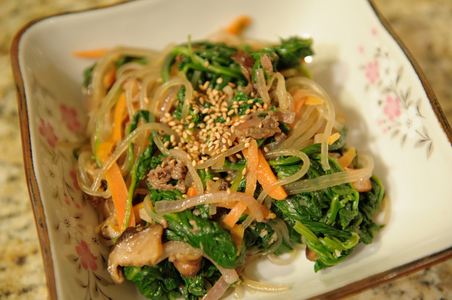Happy New Year! Do you have any fun New Year traditions? I think it’s fascinating to learn about different cultures, and traditions and foods are a wonderful insight into other people’s way of life. For instance, my Mom used to make a pork roast with sauerkraut and mashed potatoes on New Year’s Day, as it is the Pennsylvania Dutch “good luck” food for the new year. I never knew why, but a little research uncovered this bit of trivia: Pigs root forward, while chickens and turkeys scratch backwards, so eating pork is a symbol of positivity and looking forward to the good things in life. We always spend New Year’s Day with my Korean in-laws, so I am learning about Korean “good luck” food too!
Like many other Asian cultures, Koreans eat long noodles for good luck to symbolize a long life. And my favorite Korean noodle dish is Japchae! Pronounced “Jop Cheh”, it translates to “a mixture of vegetables”, and along with the noodles and a sesame dressing, that’s about it. My mother-in-law always makes it with a little bit of beef in it, and that makes it even more filling and delicious.
The two things you’ll need to buy at the Korean store are the noodles and the mushrooms. The noodles are called “dangmyeon” and are clear noodles, made from sweet potato starch. They’re very pretty, but don’t have a lot of taste on their own. (If you can’t find them, I suppose you could try this with another noodle – I won’t tell on you!) The mushrooms are dried shiitake mushrooms. They can be pricy in American stores, but in Asian markets, they are easy to find and inexpensive.
Japchae is served warm or at room temperature. I like the leftovers for breakfast – I just warm it up in the microwave for 30 seconds. May these noodles bring long life and good luck to you and your family in the New Year!
Japchae
Ingredients:
- 4 ounces beef, sliced as thin as possible into small bite-sized strips
- 6 cloves garlic, minced
- 10 dried shiitake mushrooms
- 2 bunches spinach, tough stems trimmed and washed well
- 2 large carrots, peeled
- 1 small onion, sliced very thin
- 1/2 package sweet potato noodles, about 6 oz.
- 2 tablespoons sesame oil, maybe a little more
- 2 tablespoons soy sauce
- 1 tablespoon sugar
- 1 tablespoon sesame seeds
Directions:
- Prepare meat: Heat sauté pan and add a tablespoon of sesame oil. Add meat and 3 cloves minced garlic and cook until done. Remove from heat to a very large mixing bowl, and add 1 tablespoon soy sauce. Set aside.
- Prepare mushrooms: Place mushrooms in a bowl and cover with boiling water. Place a plate on top to keep the heat in. Let the mushrooms steep and rehydrate for about half an hour. When they are rehydrated and soft, slice thinly.
- Prepare spinach: Boil a large pot of water, and get an ice bath ready. Blanch the spinach for about 15-20 seconds. Remove spinach to ice bath, but keep the water boiling on the stove for the noodles. When the spinach is cool, squeeze out the water, but don’t crush the spinach. Add to the bowl with the meat and stir to combine.
- Prepare noodles: Put the noodles into the boiling water you used to cook the spinach in, then turn off the heat. Leave the noodles in the pot for ten minutes, then drain, and add to the meat and spinach. Toss to combine.
- Prepare carrots, onions and mushrooms: Peel carrots and cut into 2-inch lengths, then slice as thinly as possible into match sticks. Heat sauté pan, add 1 tablespoon sesame oil, and cook sliced carrots, sliced onion, the mushrooms, and the remaining garlic until the onions are soft. Remove from heat and dump it all in the bowl with the meat and noodles.
- Sprinkle with sugar and remaining soy sauce and toss again to combine. Shake on some sesame seeds and taste. You may need a bit more soy sauce or a little more sesame oil. What you are looking for: balanced umami perfection!
Explore, experiment, enjoy! — Dana
Find more recipes from Dana, Korean and otherwise, at Frugal Girlmet!
















